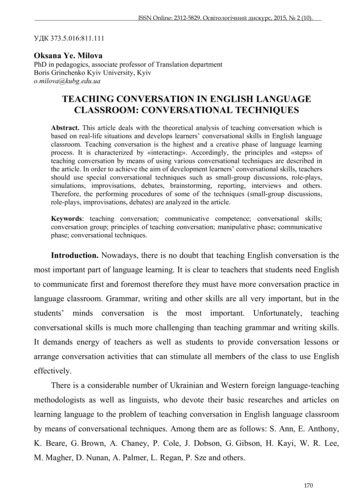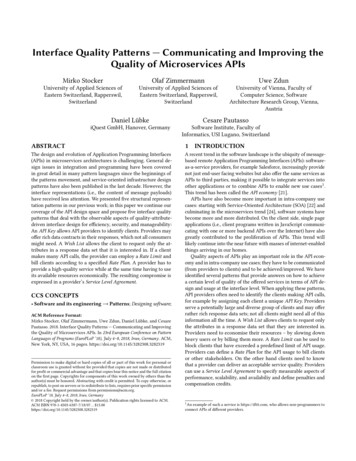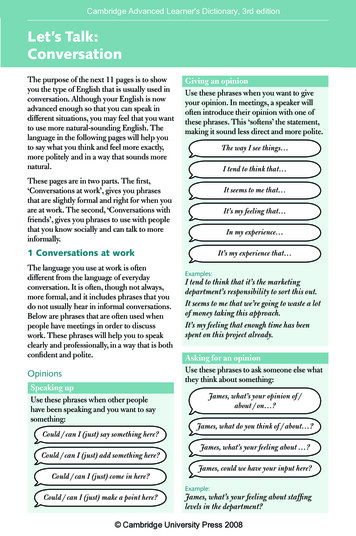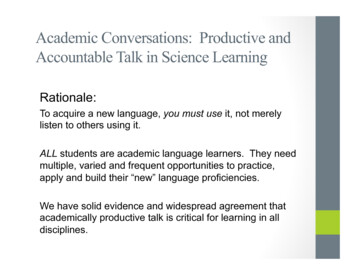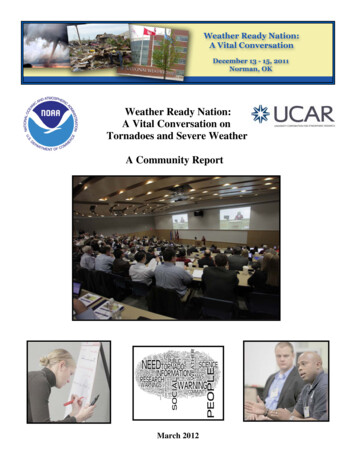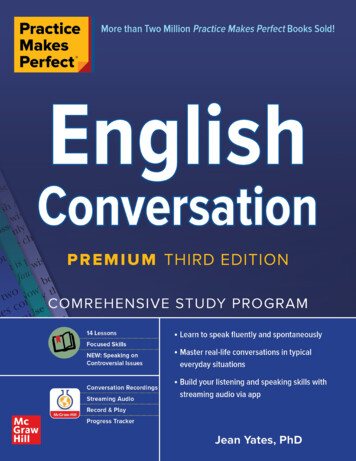
Transcription
A Community ofConversationA RetrospectiveofThe Association of Theological Schoolsand Ninety Years ofNorth American Theological EducationGlenn T. Miller
A CommunityofConversationA RetrospectiveofThe Association of Theological Schoolsand Ninety Years ofNorth American Theological EducationGlenn T. MillerThe Association of Theological SchoolsPittsburgh, Pennsylvania
2008 The Association of Theological Schools10 Summit Park Drive, Pittsburgh, Pennsylvania 15275-1110www.ats.edu
ForewordThe first meeting of what was to become The Association of Theological Schoolswas convened in 1918, ninety years ago. In recognition of this anniversary, Iasked Glenn Miller to write a brief history of ATS.Glenn Miller is uniquely qualified for the task. He has written two volumes ofthe history of Protestant theological education. The first, Piety and Intellect, isthe history from the colonial period to the Civil War and the second, Piety andProfession, covers the period of 1870 to 1970. He was educated at the Universityof Richmond, Andover Newton Theological School, and Union TheologicalSeminary, and he has served as faculty member and dean at Southeastern BaptistTheological Seminary and currently as academic dean and Waldo Professor ofEcclesiastical History at Bangor Theological Seminary. Glenn was involved in theBasic Issues Research program of the Association in the 1980s, chaired the Editorial Board of the ATS journal, Theological Education, in the 1990s, and has been afrequent accreditation evaluation committee member. He understands both thebroad ecclesial communities represented by the schools of the Association (mainline Protestant, evangelical Protestant, and Catholic/Orthodox) and the similarities and differences of theological education in Canada and the United States.A historian could approach an assignment like this in one of two ways. The firstis to write a history of the organization’s activity and use that activity as a lenson a broader range of influences in the lives of member schools. The second is towrite a history that begins with the influences and lives of member schools, anduse that broader perspective as a lens on the work of the organization. Fortunately, Glenn has chosen the second approach. ATS is an organization of the schools,and the story of its work is the story of movements and influences among anincreasingly wide community of schools. The best way to understand the Association is as the invention of the schools. Its work has been their work.An organization could commission a history like this one in one of two ways. Itcould give the historian the freedom to look at the information, use a historian’stools, and come to a historian’s conclusions. Or, it could ask the historian to writewhat the organization—or persons within it—would like to read about itself. Onthis choice, ATS could only take the first approach. This is a historian’s assessmentiii
of the history of an organization, not the organization’s assessment. It names thereligious contexts and contests that have influenced theological schools and howthese influences manifested themselves in the life of the Association.Throughout these past ninety years, ATS has sought both to serve and to lead theschools. It has been an interesting and emerging partnership. It is a story worthtelling, and Glenn tells it winsomely.Daniel O. AleshireExecutive Directoriv
Acasual observer of American religious life visiting an Association ofTheological Schools (ATS) Biennial Meeting might be perplexed. Inthe large meeting room, he or she would encounter a wide diversityof religious perspectives and educational philosophies. In addition tothe degrees of difference, the observer would be struck by the spirit of cooperation and sharing found in the group. An evangelical, a Roman Catholic, and amainstream Protestant might be exchanging information on how their schoolsresponded to new accounting procedures mandated by Sarbanes-Oxley anddescribing the shocked expressions on board members’ faces when they receivedthe first management letter from their auditors after the government extendedthe new standards to nonprofits. In another part of the room, three academicdeans might be discussing strategies for helping older, tenured faculty to retire.At some point, the whole group might listen as the executive director describesthe state of North America’s theological schools. Despite deep differences, ourobserver would be sure that he or she had found a place of comparative calmin the highly competitive North American religious marketplace. Although theattendance is overwhelmingly male and white, women and people of color arebetter represented than in past years. The observer might notice presidents anddeans who are eagerly working on strategies to incorporate Latino/a voices intheir schools’ faculties and student bodies, while others are seeking to interestAsian-American faculty in their schools.This organization was not built in a day. Its present sense of unity and purposetook ninety years to grow, develop, and prosper. The beginnings of the Association were with a handful of seminary presidents and deans of larger seminarieswho were all male and who represented schools that were, by and large, Protestant and theologically liberal. There was little racial diversity. Among AfricanAmerican schools, Gammon, a Methodist seminary in Atlanta, was a chartermember. It was joined by Howard University Divinity School in 1939. The fewAfrican-American students in Euro-American schools were often treated assecond-class citizens, subject to both formal and informal discrimination. Womenwere most often educated in separate institutions for deaconesses and/or forreligious educators, although a few were in religious education programs inseminaries and a smaller group in Bachelor of Divinity programs.1
The Crisis of the First World WarThe First World War arguably marked the end of the nineteenth century. TheEuropean nations and their colonies clashed in an epic battle that exhaustedthem culturally and politically. Although not as severely worn down, the UnitedStates, which emerged from the War as the dominant economic power, was alsochanged. While the loss of a generation of young men was itself very serious, theend of the War also marked a deep and profound cultural crisis. The confidencein European civilization that had supported three centuries of European culturaland political expansion was seriously weakened, and, as time passed, wouldwane yet further. Older cultural standards—literary, musical, sexual, educational,and religious—were in disarray, and even the foundation of the modern world,Newton’s brilliant synthesis, was under assault from a new physics, based on relativity and the quanta. Political revolution was also in the air, as radical Marxistscame to power in Russia and seemed on the verge of similar victories elsewhere.In far-off India, Gandhi’s victory in Champaran (1918) marked the beginning ofthe end of British occupation. The great missionary meeting at Edinburgh in 1910marked the high point of confidence in the Western missionary movement, butthe International Missionary Council in Jerusalem in 1928 was more sober-minded. Despite the confident affirmation of an earlier generation of young missionaries, the evangelization of the world would take more than a generation. Nor wasthe work at home any more invigorated. The World War marked the beginning ofa religious depression that would hold America in its grasp until the revival thatfollowed the Second World War, and according to some commentators convincedof the shallowness of the 1950s, continued for the remainder of the century.The organization that became The American Association of Theological Schools(AATS), later The Association of Theological Schools (ATS), was born in the shadow of this crisis. In some ways, the original motive was pragmatic. Wars are notgood for children or theological schools, and the schools were struggling to stayafloat in the midst of the struggle. President George Horr of Newton TheologicalSeminary invited the leaders of other Baptist seminaries to confer on the wartimecrisis, and President Abbott Lowell of Harvard then invited the assembled Baptists to form the nucleus of a larger group to meet in Cambridge in 1918. Whathappened next would be a theme throughout the history of the Association: conversation. When the presidents of the seminaries got together, they talked, and,2
as they did, they discovered that they had some of the same problems and dilemmas. In many ways, they did not have an agenda or a program. Instead, they hadcommon questions, including some that were basic, such as what is a theologicalseminary, how are people (mainly men) admitted to it, how does a theologicalschool relate to the broader world, to the academy, to the church?These questions had been posed by the turmoil and chaos of the nineteenthcentury. During that period, the United States had gone from colony to industrialpowerhouse, from a nation with only a few rudimentary academies and collegesto a nation studded with high schools and universities. Above all, it had gone froma nation in which the enterprising and ambitious young man could find his wayinto any profession, with a short period of study or on-the-job training, to a nationthat increasingly honored the marks of professionalization: degrees, associations ofpractitioners, social status, and financial rewards. How did the theological schoolsfit into this mix? Should they become like the new (and very successful) Universityof Chicago and embrace the new professionalism and its standards? Or perhaps,should they follow the more democratic way of a Moody Bible Institute and rushas many eager young men and women onto the field as quickly as possible? And,on a more basic level, what should they teach? Although theology had as definitea curricular tradition as any of the professions and, perhaps, more formed than thetradition in medicine, the inherited curriculum of Hebrew and Greek, dogmatictheology, and preaching had been corroded by the acids of modernity. Higher criticism had challenged the historical and scientific truth of the Bible. And when thenew biblical studies were joined with modern science, the new insights weakenedreceived theological affirmations or, as the more radical theologians affirmed, rendered those affirmations unbelievable. Even those who insisted that the traditionalfaith was nonetheless still intact did so in ways that separated the wheat from thechaff, the “fundamentals” from the rest of sacred doctrine.Information, PleaseWhether it was the cleverness of the original members of the predecessor ofATS, the Conference of Theological Schools, or only a sign of the depths of theirconfusion, they decided not to proceed directly to solutions but to try first, at leastmodestly, to assess their situation. Their first attempt was a survey by RobertKelly, published in 1924 as Theological Education: A Study of One Hundred and3
Sixty-One Theological Schools in the United States and Canada. In some ways, Kellymodeled his work on the epic study by Abraham Flexner, Medical Education in theUnited States. Flexner’s study had found a chaos in medical education in which“for-hire” schools, often inadequate in staffing and laboratory facilities, were operating alongside such new research institutions as Johns Hopkins and HarvardMedical School. Once the facts were evident, Flexner felt that the way forwardwas the classic “no brainer,” and the medical profession agreed. The number ofmedical schools in operation went down, and the quality of those that remainedwent up. The whole system of medical education was improved.Kelly clearly hoped for a similar result. While he found some seminaries operating on a very high professional level, including Union Seminary (New York) andthe University of Chicago Divinity School, he found many more to be under financed, under enrolled, and poorly equipped. Admission was often more contingent on the ability of students to support themselves than on their proven scholarly capacity or even religious suitability. Although some of the leaders of theConference of Theological Schools had worked as persuasively as possible behindthe scenes to persuade Kelly to modify his conclusions, he followed his data totheir natural conclusion: there were too many theological schools, operating withtoo low standards and too few resources, to produce the type of religious leadersthat Kelly, a typical Protestant liberal, believed the churches needed.Accreditation as a Way ForwardWithout drawing the cynical conclusion that the Conference wanted to “cook thebooks,” the seminary presidents argued that a more adequate survey needed tobe undertaken. While they were right about various weaknesses in Kelly’s study,and particularly of his rhetoric, they were also reacting to the sting of the study.Enlisting the aid of the Institute for Social and Religious Research, a religious andphilanthropic organization entirely funded and controlled by John D. RockefellerJr., they secured the funding for a more comprehensive, and, they hoped, morefavorable, study. But there was a price to pay. In exchange for funding the study,Rockefeller’s staff insisted that the Conference become an accrediting agency, anAmerican Association of Theological Schools. Whatever may have been the presidents’ hopes, both Rockefeller and the subsequent study conceded Kelly’s mainpoints: something had to be done to improve seminary standards.4
Accreditation was a relatively new idea. In the 1890s, colleges and universitieshad begun to form voluntary associations to protect the quality of their degrees.In part, this move was because the various state governments—with the notableexception of New York—failed to provide adequate supervision of the variousinstitutions that they incorporated and chartered. In addition, as the standardsshifted from the inherited classical program to an elective and scientific program,schools had a number of problems, including the always vexing issue of transfercredits that necessitated agreements among them on minimal standards. Theproblem was that accreditation was designed for colleges and universities. Thelarge regional accrediting bodies would not admit seminaries until the 1960s and,in some regions, the 1970s. The Institute for Social and Religious Research, in effect, was forcing the schools to take responsibility for their own common life.A new study, by theologian William Adams Brown and Mark A. May, whosefocus was on the formation of character, was published in four volumes underthe title of the Education of American Ministers. Although the study relied on thepopular survey technique, much of the work’s power came from its definitionof theological education as professional education. Ministers were trained to doa job, and the churches that hired them had a right to expect their employees tobe competent and efficient. This understanding tried to leapfrog over one of themost persistent problems in historical North American theological education: itsclose relationship to the doctrinal traditions of the churches. By stressing whatProtestant ministers did, Brown-May used a functional analysis of the theologicalcurriculum to compare and contrast the work of different schools. One reason itsucceeded, or appeared to, was that almost all the schools in the Conference, withthe notable exceptions of Princeton and Southern Baptist Theological Seminary,were liberal institutions that shared many theological commitments.A Low Bar SetThe new Association initially bore the marks of its origins in the midst of theDepression. Although the standards were not high, the members of the firstCommission on Accrediting—Edward Roberts, Lewis Sherrill, Everett Herrick,Abdel Ross Wentz, Arthur McGiffert Jr., Robert Davidson, Luther Weigel, AlbertBeven, Lavens Thomas, and Stanford Fleming—admitted that the standards weremore aspirational than regulatory. This meant that the Commission had to use its5
judgment in determining when it needed to rigorously enforce certain standardsand when it needed to downplay or overlook deficiencies. The Association’smeans of enforcement reflected its ambiguities. When a school failed to meet thestandard in a given area, the Commission might impose a “notation” that wouldbe published yearly with the list of member schools, initially a system of publicdisclosure of deficiency.Perhaps the most significant of the standards’ “shall” statements was the insistence on four full-time faculty members as the minimum number for accreditation. The size of the faculty was an important benchmark of educational effectiveness since most seminaries, even the largest, had only a minimum numberof staff positions, and faculty workloads often included tasks that would later beassigned to administrative offices, including the registry and the library.The most recalcitrant issue was the old question of the four-three pattern (fouryears of undergraduate work and three years of seminary). This would notbecome normative in legal and medical education until after the Second WorldWar, and many other professions had incorporated their basic training into thejunior and senior years of college, with a master’s program for those seekingadvanced study. Most university leaders passionately supported this pattern,and many seminaries found that a two-year program followed by three years oftheological study, the Bachelor of Theology degree, suited their candidates’ abilities and financial constraints better than a purely graduate degree. Although oneissue in the debate over the four-three pattern was whether sufficient numbers ofstudents who had completed the Bachelor of Arts could be enrolled to keep theschool viable, there were other substantial intellectual and educational dilemmas. For example, the key requirement, the four-year undergraduate program,was not defined, and no one had demonstrated convincingly that there was aninherent relationship between the liberal arts degree and the study of theology.The best that the Association accomplished, after years of impassioned debate,was a recommended list of prerequisite studies that seminaries might or mightnot require of potential students. And even as a voluntary measure, it was unableto stand the test of time. When enrollments fell in the 1970s and 1980s, these suggestions passed by the board. The compromise over the four-three pattern wasa rule that permitted schools to enroll up to 10 percent of their students withouta college degree. This rule, in various forms, has remained as part of the ATS6
standards. The other decision, perhaps equally influential, was to concentrate onthe Bachelor of Divinity degree (after 1970, the Master of Divinity degree) as thebasic theological program.What did it mean to be accredited? One thing it did not mean was that seminaryattainments were automatically lifted to equal status with other professional orgraduate schools. Both Brown-May and Kelly made it clear that the majority ofseminaries was struggling to perform at that level and that only a few strongschools, including Union (New York), Princeton, Vanderbilt, and Yale, were inthat class. Nor did it mean that seminaries had automatic standing in highereducation. Accreditation was only beginning to be an important criterion forcertifying institutions, and the North American educational marketplace was stillrelatively open and free of regulation. The Second World War, which required thestandardization of everything from airplane parts to qualifications for the officercorps, would elevate all accredited institutions. This was particularly true of thechaplains, where the military’s task of finding officers qualified to serve as bothministers and leaders was complicated by the seemingly endless array of qualifications for ordination. Graduation from an accredited institution was an easyway to cut through the confusion and enable quick appointments. But at first, tobe honest, accreditation mattered little in terms of status. What it did do was todistinguish some seminaries as part of a culture of aspiration and improvement.In many ways, determining the impact of those early standards is a classicalproblem in historical causality. The standards did set goals that seminary presidents, especially those embarrassed by notations, sought to meet. But impossibleor improbable goals may have less influence than no goals at all. The standards,however, were only part of the early work of the Association. While historiansgenerally do not like to reference conversations as source material, they are oftenthe real origins of many of the events, developments, and other changes that thechronicler seeks to explain. And in fact, the early AATS was, like the earlier Conference of Theological Schools, preeminently a place for conversations. The annual meetings were characterized by the presentation of papers and by organizeddiscussion of the ideas presented in them. But, like other professional organizations, the real business may well have been done in the halls as presidents anddeans exchanged ideas, shared solutions to problems, bragged about their successes, analyzed their failures, and generally became comfortable in each other’s7
presence. If nothing else, these conversations broke down the parochialism ofseminaries that were often embedded in the narrowness of their local denominational politics. A good dinner, with understanding colleagues, can do much tohelp solve a dilemma or to inspire a person to take an important course of action.Conversations would become even more important as AATS moved forward.Although the leaders of the Association did not give a name to this process, theywere in essence conducting a program of peer education in which professionalsprovided other professionals with the benefits of their knowledge and experience. What was creative about AATS was not that any of the particular elementswas necessarily new; lectures and presentations were part of every academicgathering, and professional groups, dating back to the medieval guilds, had combined meals and discussion. The way that AATS adapted these various elementsto the situation of theological schools and their leadership, however, was a markof the Association’s life. Unlike colleges and universities with their well-developed career ladders, theological schools were small and often had to elect leaderswith little, if any, experience in the field. It was a rare Henry Pitney van Dusenwho had been groomed for the position and nurtured step by step toward fullresponsibility. Hence, these school leaders needed all the help they could get, andwelcomed every opportunity to receive it.Renewal in the 1950sThe Depression took a heavy toll on theological schools. They did not expanddepartments, lacked funds for scholarships and other forms of student aid, andmade few new appointments. The immediate effect of the Second World War,which drained significant numbers of men into the armed forces, was to stallthe development of the schools even further. But the post-War religious revival,whether genuine or not, provided the money and resources needed for advancement. Even Baptists and Methodists, who had historically drawn many of theirministry leaders from those with high school education or less, began to adoptregulations that first urged and then mandated seminary education. Old schoolswere renewed and new schools were founded. Almost all expanded their faculties and built new buildings to serve those now attending on the GI Bill.8
At the same time, the theological renaissance of the 1940s and 1950s madetheological education more exciting. Although biblical scholars did not ignorethe painstaking work of historical and textual study, there was a widespread attempt to show how the Bible spoke to the contemporary situation, and the art ofinterpretation became a primary focus. Biblical studies, which had seemed on theverge of a new scholasticism, had become vital again. And the theological discussion included some remarkably interesting figures: Barth and Brunner, Tillichand Bultmann, Reinhold and H. Richard Niebuhr, Bonhoeffer, and the archeologist Albright. Nor were these discussions confined to the seminaries. During the1930s and 1940s, the denominational colleges established very strong departments of Bible and religion that introduced many potential seminary students tothese discussions before they went on to seminary.Among the first areas to demand systematic attention in this renewal processwere seminary libraries. In many ways, the libraries had been the orphan children of the seminary system. Despite the success of such nineteenth-centuryschools as Andover (later Andover Newton), Rochester (later Colgate Rochester), and Union (New York) in accumulating strong collections, most seminarylibraries in the early twentieth century were poorly staffed and lacked systematicacquisitions policies. In times of financial retrenchment, library expenses wererelatively easy to cut. Few had trained librarians, and many of the sophisticatedpolicies and procedures common to the better colleges and universities had notyet been adopted. By the late 1930s the regional accreditation organizations hadbegun to respond by devoting increasing attention to libraries.Library trends at colleges and universities also played an influential role. Many undergraduate schools were downplaying the role of textbooks, especially in the areaof a student’s major, and students expected teaching at the same level when theyarrived in seminaries. Reading lists of important secondary works, reproducedby the all-but-universal mimeograph machine, accompanied the now commonsyllabus or course outline. In some schools, small classes, often a byproduct of theschool’s financial difficulties, meant that discussion, long favored by professionaleducators as a method of instruction, had become more common as a teachingmethod. Ideally, the discussion class allowed students to bring a variety of resources to the classroom, and the reserved shelf, a special part of the collection set asidefor each course, received increased interest from teachers and librarians.9
In 1946, the American Association of Theological Schools helped to create theAmerican Theological Library Association. It was the beginning of a long andsuccessful collaboration among AATS, seminary leaders, and the libraries. Oneof the most important features of this partnership was the expansion of the AATSmodel of intensive conversations and peer-based education. As part of the effortto strengthen the libraries, the Association would later administer a significantgrant from the Sealantic Fund for their benefit.The 1950s were a very important decade for theological schools. Accreditation,which had proven important in certifying ministers for military chaplaincypositions, became an important mark of academic quality, and there was anincreasing awareness that the seminaries would have to join the larger Americanacademic order. Only a few schools, for example, were able to transfer their credits to other graduate or professional programs. Yet there was a general optimismin the air that was reflected in two important events: the commissioning of thestudy by H. Richard Niebuhr, Daniel Day Williams, and James Gustafson and theSealantic grants.The Niebuhr-Williams-Gustafson report was commissioned by AATS in 1952.The project reflected the general optimism of the post-War religious revival. Thepicture of struggling institutions that had been painted by Kelly and Brown-Maywas no longer accurate, and the theological renaissance had made the implicittheological liberalism of the earlier study seem dated. It was a time to celebratethe Advancement of Theological Education, as the study would be titled, as well asto name remaining areas of concern, such as the need for better education of thenext crop of seminary teachers. Further, Niebuhr-Williams-Gustafson raised acentral issue for the future: What was theological about theological education?The question was, of course, as much a product of the religious revival as it wasof the theological renaissance. Liberal and neoorthodox observers had noted,sometimes with pain and sorrow, that the religious revival of the 1950s was oftenshallow and frequently linked to patriotic fervor. In turn, the three researchers were turning the question against the seminaries that were supported andspawned by that revival. But the question had more bite than that: acute observers realized that the heyday of denominationalism had passed and with it hadpassed the clear visions of theological education enshrined in the great Reformation confessions.10
The other major event of the decade was the large Sealantic Fund grant that wentto the Association. The Sealantic grants were the brainchild of John D. RockefellerJr. and his staff. Rockefeller was the almost indefatigable champion and financialsponsor of liberal Protestant enterprises, and his fingerprints could be found onthe finances of such stalwart liberal schools as Union in New York, the leadinguniversity-related divinity schools, and many African-American theological andundergraduate schools. The newly created National Council of Churches, handsomely housed at 475 Riverside Drive in New York City, was almost a monumentto his belief in the power of liberal religion to transform the nation. The grant tothe Association was intended to provide the body with both a permanent officeand an executive director.Five people have held the office of executive director in AATS/ATS: CharlesTaylor 1956–1968, Jesse Ziegler 1968–1980, Leon Pacala 1980–1991, James L. Waits1991–1998, and Daniel O. Aleshire 1998–present. Outside of its accreditation functions, supported by members’ dues, the Association has had to find support forits work among a host of funding agencies. In effect, the
Theological Seminary and currently as academic dean and Waldo Professor of Ecclesiastical History at Bangor Theological Seminary. Glenn was involved in the Basic Issues Research program of the Association in the 1980s, chaired the Edito-rial Board of the ATS journal, Theological Education, in the 1990s, and has been a



